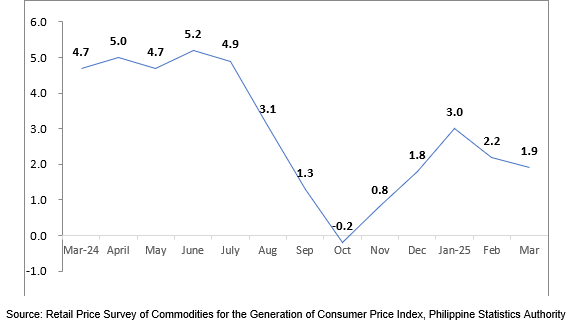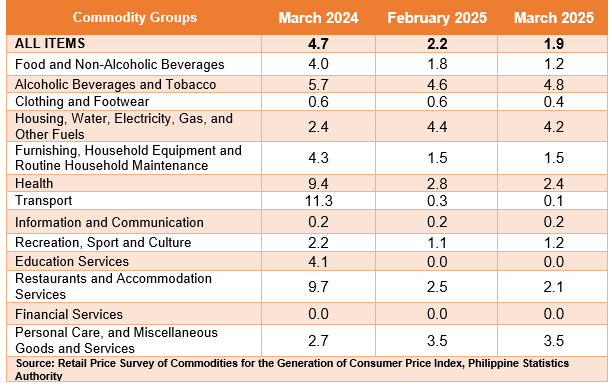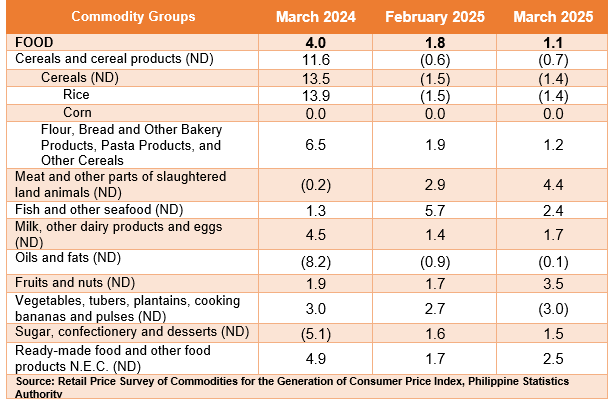Table A. Year-on-Year Inflation Rates, All Items
In percent
(2018=100)

Figure 1. Headline Inflation Rates in Benguet, All Items
(2018=100)

Table B. Year-on-Year Inflation in Benguet, By Commodity Groups
In percent
(2018=100)

Table C. Year-on-Year Food Inflation in Benguet
In percent
(2018=100)

Benguet
Headline Inflation
The headline inflation or overall inflation of the province decreased to 1.9 percent in March 2025 from 2.2 percent in Februry 2025. In March 2024, the inflation rate was higher at 4.7 percent. (Figure 1, and Tables A and B)
Main Drivers to the Downward Trend of the Headline Inflation
The downward trend in the overall inflation in March 2025 was primarily brought about by food and non-alcoholic beverages at 1.2 percent from 1.8 percent in the previous month. Also contributing to the downward trend was housing, water, electricity, gas and other fuels with an annual increase of 4.2 percent during the month from a 4.4 percent annual in the previous month, and transport with 0.1 percent from 0.3 percent.
Lower annual increments were also noted in the indices of the following commodity groups during the month:
a. Health, 2.4 percent from 2.8 percent;
b. Restaurant and accommodation services, 2.1 percent from 2.5 percent; and
c. Clothing and footwear, 0.4 percent from 0.6 percent.
On the contrary, the following commodity groups exhibited a higher annual increase during the month:
a. Alcoholic beverages and tobacco, 4.8 percent from 4.6 percent; and
b. Recreation, sport and culture, 1.2 percent from 1.1 percent.
The indices of the rest of the commodity groups retained their respective previous month’s annual rates.
Main Contributors to the Headline Inflation
The top three commodity groups contributing to the March 2025 overall inflation were the following:
a. Housing, water, electricity, gas and other fuels;
b. Food and non-alcoholic beverages; and
c. Restaurants and accommodation services.
Food inflation at the provincial level decreased to 1.1 percent in March 2025 from 1.8 percent in the previous month. In March 2024, food inflation was higher at 4.0 percent. (Table C)
Main Drivers to the Downward Trend of Food Inflation
The deceleration of food inflation in March 2025 was primarily brought about by vegetables, tubers, plantains, cooking bananas and pulses with -3.0 percent from 2.7 percent in the previous month. This was followed fish and other seafood with 2.4 percent from 5.7 percent, and cereals and cereal products with -0.7 percent from -0.6 percent.
Lower annual increment was also noted for sugar, confectionery and desserts with 1.5 percent from 1.6 percent.
In contrast, the following commodity groups registered higher inflation rates during the month:
a. Meat and other parts of slaughtered land animals, 4.4 percent from 2.9 percent;
b. Milk, other dairy products and eggs, 1.7 percent from 1.4 percent;
c. Oils and fats, -0.1 percent from -0.9 percent;
d. Fruits and nuts, 3.5 percent from 1.7 percent; and
e. Ready-made food and other food products n.e.c., 2.5 percent from 1.7 percent.
Main Contributors to the Food Inflation
The top three food groups in terms of contribution to the food inflation during the month were the following:
a. Meat and other parts of slaughtered land animals;
b. Fish and other seafood; and
c. Cereals and cereal products.
Note: CPIs and inflation rates by region, province and selected city are posted at the PSA website (https://openstat.psa.gov.ph/).
IMELDA L. BUYUCCAN(SGD)
Chief Statistical Specialist
/DJPN

